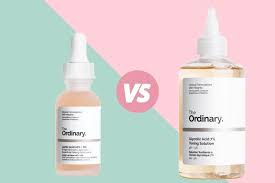
Can I use Glycolic Acid and Lactic Acid Together?
Glycolic acid and lactic acid are both members of the Alpha Hydroxy Acid (AHA) family. Both ingredients help to chemically exfoliate the skin working on the outer surface and sloughing away the build-up of dead skin cells, dirt, and impurities. By ridding the face of this debris, you will find the skin appears fresher and more vibrant with fine lines and wrinkles notably reduced. You’ll find that your other skincare products are able to absorb rapidly and begin to show results quickly without having to compete with the barrier created by dead skin cells.
Each acid can be formulated with various percentage levels, with the most potent of the two being glycolic acid. Due to the molecular size being smaller it is able penetrate further down into the skin. This doesn’t necessarily mean glycolic acid is the most effective, it is however more suitable for those with a skin type that is combination or oily. For those with a dry skin type that is prone to mild sensitivity, lactic acid can step in and provide exfoliation without the worry of irritation. Compared to glycolic acid the molecular size of lactic acid is very large making it unable to penetrate too far into the pores, but instead works on the outer surface. It is also able to hydrate the skin surface thanks to the humectant traits of the acid enabling it to lock moisture into the protective barrier.
Now that I have given you a quicker refresher on the main benefits of these acids, let’s find out more about whether you can use glycolic acid and lactic acid together?
Can I use glycolic acid in the morning and lactic acid at night?
You could, but only if your skin remains happy and healthy with this routine. If you are wanting my advice, I would suggest using lactic acid in the morning and glycolic acid for the evening. Whichever acid you choose to use it is very important you apply a daily SPF of 30 and above, even on days that are cloudy.
The potency of the formulas and percentage of active levels will determine how they work on the skin. For example, face wash and toners contain a lower percentage in their formulations compared to serums and moisturisers.
Should I start with glycolic acid or lactic acid?
If you are new to acids, or perhaps you are wanting to use both in your routine, it is best to start gently. With this is mind, start by using lactic acid as it is gentler and offers an added boost of hydration, once your skin has built a tolerance to it you can swap it over to glycolic acid formulations. It is important to remember that with any skincare product you must perform a 24-hour patch test to ensure your skin remain comfortable and you avoid any unwanted irritation. If you have any concerns its best to consult with a doctor, dermatologist, or medical professional to give you some reassurance.
Is lactic acid a good exfoliator?
Yes, lactic acid is a great exfoliator, you’ll find that this acid is frequently blended into a variety of formulas. Having said that, the most common products containing active levels of lactic acid are toners and cleansers. When using an exfoliating toner, the percentage of the acid will be quite high but because toners are a product that generally don’t remain on the skin for extended periods of time, there is limited amount of skin irritation.
With lactic acid being the gentlest yet highly effective chemical exfoliant anyone would benefit from using it their daily skincare routine. However, if you have a skin type that is very oily or perhaps acne prone you may want to opt for a formula containing the BHA, salicylic acid.
Can you use glycolic acid after exfoliating?
No, it is best to avoid using glycolic acid after exfoliating. If it is a physical scrub you have used for exfoliation, I would strongly advise against using any other form of exfoliate on the skin. Although glycolic acid may feel as though it is not as potent on the skin compared to a scrub, it can in fact reach into the different layers of the epidermis. This can be overstimulating and will result in negative results such as, redness, flaking, itchiness and rashes. You will also find that when you over exfoliant the skin the natural oil, also known as sebum, is stripped leaving the face feeling dry and uncomfortable.
Does lactic acid stimulate collagen?
Yes, it does! When used regularly lactic acid can improve signs of ageing, such as fine lines and wrinkles as well as stimulating the production of collagen. After roughly 4 weeks you can expect to see an improvement on the over-all complexion. Signs of hyperpigmentation, dark spots, loss of elasticity and lack lustre finish to the skin are all improved with minimal disruption to the natural protective barrier.
Does glycolic acid lighten skin?
No, glycolic acid does not lighten the skin. It can however help combat uneven skin tone, darks spots and signs of hyperpigmentation. It can do this by working on the surface of the skin and sloughing away dead skin cell build-up. When there is a build-up of dead skin cells that are not removed the overall look of the complexion will appear dull and sallow. Dark spots and other forms of sun damage will also look darker, by removing the excess, unwanted layers you are removing the pigmentation of the areas of uneven skin tone giving you a brighter, even finish to the complexion.
Does lactic acid shrink pores?
Yes, it can make pores appear less visible, the trouble with pores is that once they have become enlarged, you are unable to shrink their size again. Having enlarged pores isn’t the end of the world, as difficult and frustrating they are, with the help of lactic acid you are able to keep them clear and unclogged of any build-up of impurities.
So, I hope that today I have answered some questions about using glycolic acid and lactic acid together. Don’t forget if you any other questions please come and follow us over on the Procoal Instagram.


